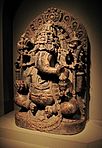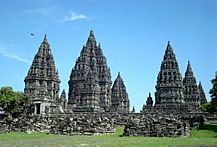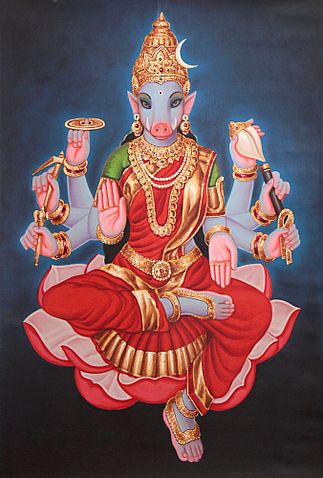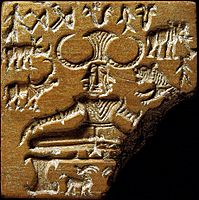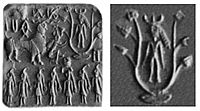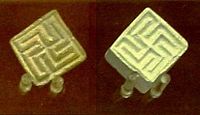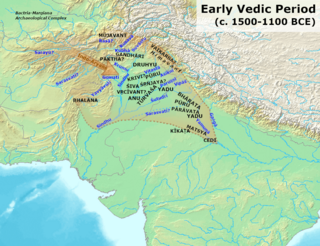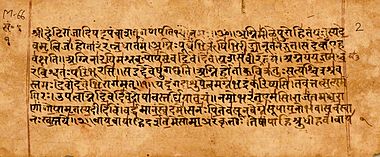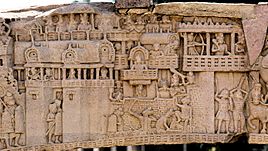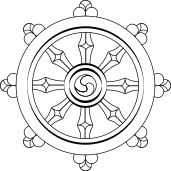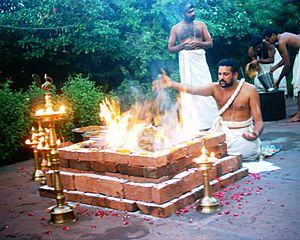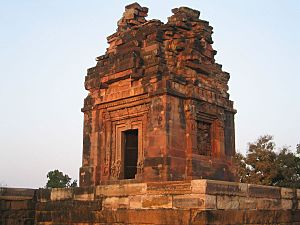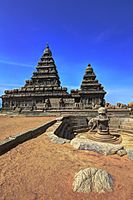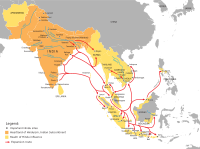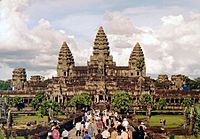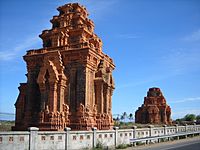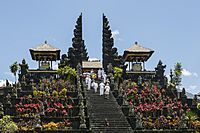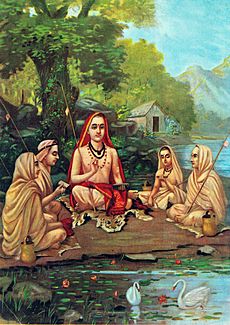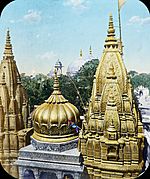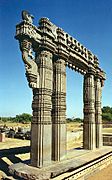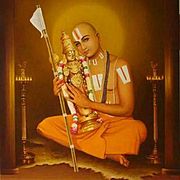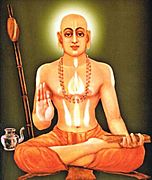History of Hinduism facts for kids
The history of Hinduism tells the story of many different religious traditions from India. It goes way back to the Iron Age, and some parts even come from very old religions like those of the Indus Valley Civilisation from the Bronze Age. Because of this, Hinduism is often called the "oldest religion" in the world.
Experts believe Hinduism grew from a mix of different Indian cultures and traditions. It doesn't have one single founder. This "Hindu synthesis" started after the Vedic period, between about 500 BCE and 300 CE. It really grew during the Middle Ages, especially as Buddhism became less common in India.
The history of Hinduism is usually split into different time periods. First, there's the pre-Vedic period, which includes the Indus Valley Civilization. This ended around 1750 BCE. Then came the Vedic period in northern India, when the historical Vedic religion arrived with the Indo-Aryan migrations. This started between 1900 BCE and 1400 BCE.
The time between 800 BCE and 200 BCE was a big turning point. It was a time when Hinduism, Jainism, and Buddhism really started to take shape. From about 200 BCE to 500 CE, important stories like the Epics and the first Puranas were written. This was followed by the "Golden Age" of Hinduism (about 320-650 CE), which happened during the Gupta Empire. In this time, six main types of Hindu philosophy developed. Also, groups that worshipped one main god, like Shaivism (for Shiva) and Vaishnavism (for Vishnu), grew through the Bhakti movement. The period from about 650 to 1100 CE is called the late Classical period. During this time, the classical Puranic Hinduism became well-known, and Adi Shankara brought together the ideas of Advaita Vedanta.
Under both Hindu and Islamic leaders from about 1200 to 1750 CE, the Bhakti movement became even more important. It still influences Hinduism today. During the colonial period, new Hindu reform movements appeared, partly inspired by ideas from the West. When India was divided in 1947, the Republic of India became a country with a Hindu majority. In the 20th century, many Hindus moved to other parts of the world, forming communities in places like the United States and the United Kingdom.
Contents
- How Hinduism Began
- Periods of Hinduism's History
- Early Religions (Before 1750 BCE)
- Vedic Period (About 1750–500 BCE)
- New Ideas and Changes (About 600–200 BCE)
- Hindu Synthesis and Classical Hinduism (About 200 BCE – 1200 CE)
- Medieval and Early Modern Periods (About 1200–1850 CE)
- Modern Hinduism (After 1850 CE)
- Contemporary Hinduism
- Images for kids
- See also
How Hinduism Began
Experts see Hinduism as a mix of different Indian cultures and traditions. It grew from many sources. One important source is the historical Vedic religion. This religion was already a mix of Indo-Aryan and Harappan cultures. It later became the Brahmanical religion in the Kuru Kingdom of Iron Age northern India.
Other roots include the Śramaṇa traditions from northeast India, and older cultures from the Stone Age. These include the religions of the Indus Valley Civilisation, Dravidian traditions, and local and tribal religions.
This "Hindu synthesis" happened after the Vedic period, between 500 BCE and 300 CE. This was during a time of new city growth. During this time, the Epics and the first Puranas were written. This new Brahmanical way of thinking included ideas from Sramanic groups and Buddhism. It also included the growing bhakti (devotion) tradition through religious writings called smriti. This mix happened partly because Buddhism and Jainism were becoming very popular.
During the Gupta rule, the first Puranas were written. These stories helped spread "mainstream religious ideas" to groups who didn't read much. The Puranic Hinduism that resulted was quite different from the older Brahmanism. Hinduism and Buddhism existed side-by-side for centuries. But by the 8th century, Hinduism became more dominant.
From northern India, this "Hindu synthesis" spread to southern India and parts of Southeast Asia. This happened as rulers in these areas adopted the Brahmanical culture. It was helped by Brahmins settling on land given by local rulers. Also, popular non-Vedic gods were included and local cultures were blended in. This blending explains why there are so many different local cultures in India, yet they all share a common thread.
According to Eliot Deutsch, Brahmins were key to this blending. They spoke both their local language and a common form of Sanskrit. This helped them connect the larger culture with village life. They could "translate the mainstream of the large culture in terms of the village." While some Brahmins stuck to old Vedic ways, new Brahmins wrote prayers for local gods. They became leaders of these local traditions.
Periods of Hinduism's History
Historians have divided India's history into different periods. One old way was Hindu, Muslim, and British civilizations. This way has been criticized because it doesn't show the full picture. Another way is "ancient, classical, medieval, and modern periods."
A more detailed way to look at the periods is:
- Pre-history and Indus Valley Civilisation: Until about 1750 BCE.
- Vedic period: About 1750-500 BCE.
- "Second Urbanisation": About 600-200 BCE, when new cities grew.
- Classical Period: About 200 BCE-1200 CE.
- Pre-classical period: About 200 BCE – 300 CE.
- "Golden Age" of India (Gupta Empire): About 320–650 CE.
- Late-Classical period: About 650–1200 CE.
- Medieval Period: About 1200–1500 CE.
- Early Modern Period: About 1500–1850 CE.
- Modern period: From about 1850 CE, including British rule and independence.
Early Religions (Before 1750 BCE)
Prehistoric Times
Hinduism might have roots in very old religions from the Stone Age. For example, rock paintings in the Bhimbetka rock shelters are about 10,000 years old. Some of these shelters were used by people over 100,000 years ago. Some Hindu practices today, like worshipping certain plants and animals, might come from these ancient times. The worship of goddesses might also have started in the Stone Age. Some tribal religions still exist today.
Indus Valley Civilization (About 3300–1700 BCE)
Some seals from the Indus Valley show swastikas, which are symbols found in many religions. Many seals also show animals. One seal shows a figure with horns, sitting like someone doing yoga, surrounded by animals. Early explorers called this "Pashupati" (Lord of the animals), a name used for the later Hindu gods Shiva and Rudra.
Because many small statues of women were found, some experts think the Harappan people worshipped a mother goddess. This goddess would have symbolized fertility, which is still common among Hindus today. However, some disagree with this idea.
There are no religious buildings or fancy burial sites found in the Indus Valley. If there were temples, we haven't found them yet. But one house in Mohenjadaro's Lower Town might have been a temple.
-
The so-called Shiva Pashupati seal from the Indus Valley Civilisation.
-
Fighting scene between a beast and a man with horns, hooves and a tail. Indus Valley Civilisation seal.
-
Swastika Seals from the Indus Valley Civilization at the British Museum
Vedic Period (About 1750–500 BCE)
The early Vedic age is thought to be around the 2nd millennium BCE. Vedism was the religion of the early Indo-Aryans. These people spoke old Indian languages and came from Central Asia.
Where the Vedic Religion Came From
The Vedic period is named after the Vedic religion of the Indo-Aryans. It lasted from about 1750 to 500 BCE. The Indo-Aryans were part of the Indo-European language family. Many scholars believe they came from the Kurgan culture in the Central Asian steppes. The Vedic religion, including names of some gods, was similar to religions of ancient Greeks, Romans, Persians, and Germanic peoples. For example, the Vedic god Dyaus is like the Greek Zeus and Roman Jupiter.
The Indo-Aryans were herders who moved into north-western India after the Indus Valley Civilization ended. They were a branch of the Indo-Iranians. The Indo-Iranians split into Indo-Aryans and Iranians around 1800-1600 BCE.
During the Early Vedic period (about 1500 – 1100 BCE), Indo-Aryan tribes were herders in north-west India. After 1100 BCE, they started using iron and moved into the western Ganges Plain. They began farming. Small states appeared, and the Kuru tribe was the most important. This kingdom became the first recorded state-level society in South Asia around 1000 BCE. This greatly changed their religion. They collected their hymns into the Veda-collections and developed new rituals. These rituals became the orthodox Śrauta rituals, which helped create the "Hindu synthesis."
Rigvedic Religion
The Indo-Aryans brought their language and religion with them. Their beliefs were similar to other ancient Indo-European religions. The Old Indic religion likely formed where Indo-European people met other cultures in Central Asia. It borrowed some religious ideas and practices from the Bactria–Margiana culture.
The oldest writings in Old Indic, the language of the Rig Veda, are found in northern Syria, in the Mitanni kingdom. Mitanni kings had Old Indic names, and Old Indic words were used for horse-riding. The word r'ta, meaning "cosmic order and truth," was central to the Rig Veda and also used in the Mitanni kingdom. Old Indic gods, like Indra, were known there too.
Their religion grew further when they moved into the Ganges Plain after about 1100 BCE. They became settled farmers and mixed with the local cultures of northern India. The Vedic religion of this later period existed alongside local religions, like the Yaksha cults. It was already a mix of Indo-Aryan and Harappan cultures. Some scholars say Vedic religion partly comes from the Indus Valley Civilisation.
Vedas
The main religious texts are the three Vedic Samhitas: the Rigveda, Samaveda, and Yajurveda. These were texts for the priests and might not show what everyone believed. The Rig-Veda is the oldest, a collection of hymns from about 1500-1200 BCE. The other two add details for sacrifices. The Atharvaveda also has old writings, including material for home rituals and folk magic.
These texts were passed down by oral tradition for a long time. They were only written down more widely after the 4th century CE.
The Rigveda has hymns used in fire rituals (Agnihotra) and offerings of Soma to the gods. Soma is both a drink and a god. The sacrificial fire, Agni, is also a god. The royal horse sacrifice (Ashvamedha) is a key ritual in the Yajurveda.
The gods in the Rig-Veda are mostly ideas given human form. They fall into two groups: the devas (nature gods like Indra and Agni) and the asuras (gods of moral ideas like Mitra and Varuna). In later Vedic texts, "Asura" came to mean demon.
The Rigveda has 10 books. The older books share many things with the common Indo-Iranian religion. Many Vedic Sanskrit religious words are similar to words in other Indo-European languages.
Cosmic Order
Right and wrong in the Vedas are based on Satya (truth) and Ṛta (cosmic order). Satya is the main truth. Ṛta is how Satya works in the universe. Following Ṛta helps things go well, while breaking it leads to problems.
The word "dharma" was used in Brahmanical thought. It was seen as part of Ṛta. The idea of Ṛta is also found in the Proto-Indo-Iranian religion.
Upanishads
The first Upanishads were written around the 9th and 8th centuries BCE. The Upanishads are the main ideas behind classical Hinduism and are called Vedanta (the end of the Veda). The older Upanishads questioned rituals, but later ones found deeper meanings in them. The idea of many gods becoming one main principle, which started in the Vedas, became very strong in the Upanishads. The different ideas of one ultimate reality in the Upanishads were later brought together in the Bhagavad Gita.
Brahmanism
Brahmanism grew from the Vedic religion. It added non-Vedic ideas and spread across northern India. Brahmanism included Vedic texts and later texts like the Dharmasutras, which gave importance to the priestly (Brahmin) class. The focus on rituals and the power of Brahmins grew in the Kuru Kingdom. It existed alongside local religions, like the Yaksha cults.
During the Iron Age in India (about 10th to 6th centuries BCE), new kingdoms called Mahajanapadas appeared. In this time, the main parts of the Vedas were finished. Many schools of Vedic priesthood developed writings to explain the Vedas. These schools also made sure the Vedic texts were kept perfectly through oral tradition for thousands of years.
New Ideas and Changes (About 600–200 BCE)
Upanishads and Ascetic Movements
Vedism, with its strict rituals, may have faced challenges as India's cities grew in the 7th and 6th centuries BCE. New spiritual movements appeared, like Buddhism and Jainism. These movements questioned the old religious ways. Images of gods started to appear more often around this time, as the power of Vedism lessened.
Mahavira (about 549–477 BCE), who promoted Jainism, and Buddha (about 563-483 BCE), who started Buddhism, were key figures in this movement. The Sramana tradition helped create ideas like the cycle of birth and death (Saṃsāra) and the idea of liberation. These ideas became very important in Hinduism.
Decline of Brahmanism
After the Vedic period, Brahmanism faced a decline. The meaning of the Vedas became unclear, and they were seen more as magical sounds. As cities grew, Brahmins lost some support. The rise of Buddhism, the invasion by Alexander the Great, and the growth of the Maurya Empire (which supported Buddhism) also threatened Brahmanism. Later texts even called Northwest India "impure" because of invasions.
However, some parts of the Historical Vedic religion still exist today, like the Śrauta tradition. This tradition follows many Vedic elements and is found in South India, especially among the Nambudiri of Kerala.
Hindu Synthesis and Classical Hinduism (About 200 BCE – 1200 CE)
Early Hinduism (About 200 BCE – 320 CE)
The Hindu Synthesis
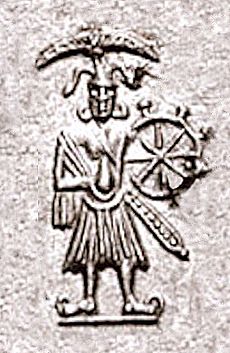
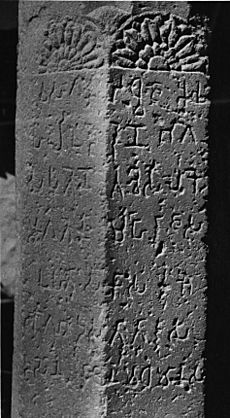
Brahmanism recovered by offering new services and including non-Vedic and local religious traditions. This led to modern Hinduism. Between 500–200 BCE and about 300 CE, the "Hindu synthesis" grew. It brought in ideas from Sramanic groups and Buddhism, and the growing Bhakti (devotion) tradition. This happened partly because Buddhism and Jainism were so successful.
Many other religious traditions existed alongside the Vedic religion. These local religions "eventually found a place under the broad mantle of the Vedic religion." When Brahmanism was struggling and competing with Buddhism and Jainism, popular local religions had a chance to become more important.
This "new Brahmanism" appealed to rulers. They liked the spiritual powers and advice Brahmins could give. This led to Brahmins becoming very influential again, dominating Indian society from the early centuries CE. This is seen in Sanskritization, where people from different parts of society started to follow Brahmanical ways of life. Local gods were also linked to the gods in Sanskrit texts.
Smriti Texts
The Brahmins responded by bringing together and simplifying ideas in the smriti literature. These smriti texts, written between 200 BCE and 100 CE, said that the Vedas were very important. Accepting the Vedas became a key way to define Hinduism, different from other religions that rejected them. Most main ideas and practices of classical Hinduism come from these new smriti texts.
The major Sanskrit epics, Ramayana and Mahabharata, were put together during these centuries. They contain old stories about rulers and wars in India. They also have religious and philosophical teachings. The later Puranas tell stories about gods and goddesses, their interactions with humans, and their fights against demons. The Bhagavad Gita brought together Brahmanic and Sramanic ideas with devotion to a god.
Schools of Hindu Philosophy
In the early centuries CE, several schools of Hindu philosophy were formally organized. These included Samkhya, Yoga, Nyaya, Vaisheshika, Purva-Mimamsa, and Vedanta.
Sangam Literature
The Sangam literature (300 BCE – 400 CE) was written in the Tamil language. It is mostly about everyday life. But some works, like Pattupathu and Paripaatal, have devotional poems about God. Vishnu, Shiva, and Murugan were mentioned. These are the earliest signs of devotion to one god (Bhakti) before the larger Bhakti movement.
"Golden Age" of India (Gupta and Pallava Period) (About 320–650 CE)
During this time, power became more centralized. Trade grew, laws became more standard, and more people learned to read and write. Mahayana Buddhism was popular. But the old Brahmana culture also became strong again, supported by the Gupta Dynasty, who worshipped Vishnu. The Brahmins became more important. The first Hindu temples dedicated to gods appeared in the late Gupta age. During Gupta rule, the first Puranas were written. These stories helped spread mainstream religious ideas to tribal groups. The Puranic Hinduism that resulted was very different from earlier Brahmanism. The Guptas supported this new Puranic religion to make their rule seem more legitimate.
According to P. S. Sharma, the Gupta and Harsha periods were the most brilliant for Indian philosophy. Hindu and Buddhist philosophies grew side by side.
Gupta and Pallava Empires
The Gupta period (4th to 6th centuries) was a time of great learning. Classical schools of Hindu philosophy and Sanskrit literature flourished. Famous thinkers like Aryabhata and Varāhamihira lived then. The Guptas had a strong government but also allowed local control. Gupta society followed Hindu beliefs, including a strict caste system. The peace and wealth under the Guptas allowed for scientific and artistic achievements.
The Pallavas (4th to 9th centuries) in the South also supported Sanskrit learning. The Pallava rule saw the first Sanskrit writings in a script called Grantha. The Pallavas built important Hindu temples and schools using Dravidian architecture.
During the early Pallava period, there were connections to Southeast Asia. In the Middle Ages, Hinduism became the main religion in many kingdoms of Asia, known as Greater India. This included places like Cambodia, Vietnam, Indonesia, and the Philippines. By the 15th century, Buddhism and Islam mostly replaced Hinduism in these areas.
Building temples for different gods became popular, along with beautiful temple architecture and sculptures.
-
The Hindu Shore Temple at Mamallapuram built by Narasimhavarman II
-
The Descent of the Ganges at Mahabalipuram, a large rock carving showing Hindu myths.
Bhakti Movement
This period saw the start of the Bhakti movement. Bhakti means devotion. It began in Tamil Nadu in Southern India with the Saiva Nayanars (4th to 10th centuries CE) and the Vaisnava Alvars (3rd to 9th centuries CE). They spread devotional poetry and worship throughout India.
Expansion in South-East Asia
-
Angkor Wat in Cambodia is one of the largest Hindu monuments.
-
Hoà Lai Towers in Ninh Thuận, Vietnam, a Hindu temple complex built in the 9th century.
-
Pura Besakih, the holiest temple of Hindu religion in Bali.
Hindu ideas reached the Indonesian Archipelago as early as the first century. India began to strongly influence Southeast Asian countries. Trade routes connected India with places like Burma, Siam, Cambodia, and Vietnam. Many cities grew along the coasts.
For over a thousand years, Indian Hindu and Buddhist influence brought cultural unity to the region. Languages like Pali and Sanskrit, Indian writing, and religions like Buddhism and Hinduism spread. Indian literature, such as the Ramayana and Mahabharata epics, also spread.
From the 5th to the 13th century, Southeast Asia had powerful Indian-influenced empires. They were very active in building Hindu and Buddhist temples and art. The Sri Vijaya Empire and the Khmer Empire were major powers.
Langkasuka was an ancient Hindu kingdom in the Malay Peninsula. It was one of the earliest kingdoms there, founded in the 2nd century.
The Sri Vijayan empire (5th to 15th centuries) was a sea empire centered on Sumatra, Indonesia. It adopted Mahayana and Vajrayana Buddhism. The Majapahit Empire followed it and was one of the last and greatest Hindu empires in maritime Southeast Asia.
Funan was an early Cambodian kingdom. It was likely founded by an Indian Brahmin named Kaundinya in the 1st century CE. He married a Khmer queen, and their family became the royal family. This story helped give power to both Indian and local traditions.
The kingdom of Champa (from about 192 to 1697) controlled parts of Vietnam. The main religion of the Cham people was Hinduism, and their culture was heavily influenced by India.
Later, from the 9th to the 13th century, the Mahayana Buddhist and Hindu Khmer Empire ruled much of Southeast Asia. Under the Khmer, over 900 temples were built in Cambodia and Thailand. Angkor was the center, with a huge temple complex. The largest temple complex in the world, Angkor Wat, was built here by King Vishnuvardhan.
Late-Classical Hinduism (About 650–1200 CE)
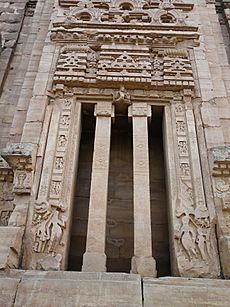
After the Gupta Empire ended, power in India became spread out. Many smaller kingdoms appeared. These smaller kingdoms depended on larger ones for protection. The main king was seen as very powerful and god-like.
This spreading of power also led to religions becoming more local. The influence of "Brahmanic ritualistic Hinduism" decreased. New movements focused on devotion and rural areas appeared, like Shaivism, Vaisnavism, Bhakti, and Tantra. These groups were just starting to form. Religions had to compete for support from local rulers. Buddhism became less popular after the 8th century and started to disappear in India. This was seen in temple ceremonies, where Hindu gods replaced the Buddha as the main god.
Puranic Hinduism
The Brahmanism of the old religious laws changed a lot because of the Purana writers. This led to the rise of Puranic Hinduism, which became very important. Puranic Hinduism was a complex belief system that grew by taking in different ideas and traditions. It was different from its Vedic roots because it was popular among many people, had many different gods and groups, used Tantric ideas, and focused on bhakti (devotion).
The early medieval Puranas were written to spread mainstream religious ideas to tribal groups who were learning new ways of life. When the Gupta empire broke down, Brahmins were given land. This helped them spread across India and interact with local groups who had different religions. Brahmins used the Puranas to bring these groups into the farming society and its religion. Local leaders and farmers were included in the varna (social classes).
Many local religions and traditions were absorbed into Puranic Hinduism. Vishnu and Shiva became the main gods, along with Sakti/Deva. Vishnu took in many local cults. Shiva also absorbed local cults by adding Isa or Isvara to the local god's name. In the 8th century, Hindu gods started to replace the Buddha in royal ceremonies. This was also when the Buddha was seen as an avatar of Vishnu.
Bhakti Movement
Rama and Krishna became central to a strong bhakti (devotion) tradition. This was especially seen in the Bhagavata Purana. The Krishna tradition included many local cults. Shiva also absorbed local cults. In 8th-century royal circles, Hindu gods began to replace the Buddha in worship. This was also the same time the Buddha was made into an avatar of Vishnu.
The first recorded bhakti movement was started by Karaikkal Ammaiyar. She wrote poems in Tamil about her love for Shiva around the 6th century CE. The twelve Alvars (Vaishnavite devotees) and sixty-three Nayanars (Shaivite devotees) helped the bhakti movement grow in Tamil Nadu.
In the 12th century CE in Karnataka, the Bhakti movement became the Virashaiva movement. It was inspired by Basavanna, a Hindu reformer who created the group of Lingayats. During this time, a unique form of Kannada poetry called Vachanas was created.
Advaita Vedanta
The early Advaitin Gaudapada (6th-7th c. CE) was influenced by Buddhism. He used Buddhist ideas that ultimate reality is pure consciousness. Shankara (8th century CE) was a scholar who organized and explained Advaita Vedanta ideas. Shankara taught that the inner self (atman) and the ultimate reality of the world (brahman) are one and the same. Seeing many different forms as the final reality is called maya, which means "illusion."
While Shankara is very important in Advaita Vedanta, his early influence in India is debated. Until the 11th century, Vedanta was not a major school of thought. And until the 10th century, Shankara was less famous than his older contemporary Maṇḍana Miśra.
Some scholars suggest that Shankara's fame grew centuries later, during the Muslim invasions. This was due to Vidyaranya (14th c.), who created stories to make Shankara a "divine folk-hero."
Shankara's ideas became even more established in the 19th and 20th centuries. This happened when new Hindu thinkers and Western scholars promoted Advaita Vedanta as the main idea uniting Hinduism. Advaita Vedanta is now widely accepted as a key example of Hindu spirituality, even though most Hindus don't follow it strictly.
Medieval and Early Modern Periods (About 1200–1850 CE)
Muslim Rule
Islam came to India in the early 7th century with Arab traders. But it started to affect Indian religions more after the 10th century, especially after the 12th century when Islamic rule began. Some historians describe the Muslim conquest of India as very violent. During this time, Buddhism quickly declined. Hinduism faced religious violence led by armies and supported by rulers. Many Hindu families were raided, captured, and enslaved. They were sold in cities or sent to Central Asia. Some texts suggest Hindus were forced to convert to Islam. From the 13th century onwards, few texts mention Hindus willingly converting to Islam, suggesting it was rare. Enslaved Hindus often converted to gain freedom.
There were some exceptions to this violence. Akbar, for example, respected Hinduism. He stopped the enslavement of Hindu war captives and protected Hindu temples. He also removed the Jizya (a tax on non-Muslims). However, many Muslim rulers, before and after Akbar, destroyed Hindu temples and persecuted non-Muslims.
-
The Kashi Vishwanath Temple was destroyed by the army of Delhi Sultan Qutb ud-Din Aibak.
Bhakti Vedanta
Teachers like Ramanuja, Madhva, and Chaitanya connected the Bhakti movement with the ideas of Vedanta. Until the 11th century, Vedanta was not a very important school of thought. These teachers rejected the abstract ideas of Advaita. Instead, they promoted strong, emotional devotion to more relatable gods, especially Krishna and Rama.
-
Ramanuja is an important leader of the Sri Vaishnavism tradition.
-
Madhvacharya, a key thinker of the Dvaita school of Vedanta.
Unifying Hinduism
According to Nicholson, between the 12th and 16th centuries, thinkers started to see the different ideas from the Upanishads, epics, Puranas, and the "six systems" of Hindu philosophy as one whole. Michaels notes that a history emerged that praised Hinduism and its past.
Some scholars believe that the fame of Shankara and Advaita Vedanta was purposefully built during this time. Vidyaranya (14th c.), a follower of Shankara, created stories to make Shankara a "divine folk-hero." Vidyaranya presented Shankara's teachings as the best of all philosophies. He had royal support, and his efforts helped make Shankara a symbol of Hindu values. He also helped establish monasteries to spread Shankara's ideas.
Eastern Ganga and Surya States
The Eastern Ganga and Surya were Hindu kingdoms. They ruled much of present-day Odisha from the 11th to the mid-16th century CE. In the 13th and 14th centuries, when much of India was under Muslim rule, Kalinga became a strong center for Hindu religion, philosophy, art, and architecture. The Eastern Ganga rulers supported religion and arts. The temples they built are considered masterpieces of Hindu architecture.
Early Modern Period (About 1500–1850 CE)
The fall of the Vijayanagara Empire to Muslim rulers ended Hindu imperial defenses in the Deccan. But Hinduism rose again politically under the Maratha Empire (1674 to 1818), taking advantage of a stretched-out Mughal Empire.
Vijayanagara Empire
The Vijayanagara Empire was founded in 1336 by Harihara I and his brother Bukka Raya I. It grew as South Indian powers tried to stop Islamic invasions. According to one story, the founders were taken to Delhi and converted to Islam. They were sent back as vassals, but later, Vidyaranya converted them back to Hinduism.
The Vijayanagara Emperors were tolerant of all religions. The kings used titles like Gobrahamana Pratipalanacharya ("protector of cows and Brahmins") and Hindurayasuratrana ("upholder of Hindu faith"). The empire's founders were devout Shaivas (worshippers of Shiva), but they also supported the Vaishnava order. They used Varaha (the boar, an avatar of Vishnu) as their symbol. Later kings were Vaishnava but worshipped at both Shiva and Vishnu temples. The king Krishnadevaraya called Lord Virupaksha the "protective jewel of Karnata Empire." The kings supported the saints of the dvaita order of Madhvacharya.
-
Virupaksha Temple is dedicated to Lord Virupaksha, a form of Shiva.
The Bhakti movement was active then, with famous saints like the Haridasas. This movement brought strong devotion to millions. The Haridasas had two groups: Vyasakuta (who knew the Vedas) and Dasakuta (who spread Madhvacharya's message through songs). The philosophy of Madhvacharya was spread by important students. Vyasatirtha, a teacher, was highly respected by King Krishnadevaraya. Another great composer, Annamacharya, wrote hundreds of songs in Telugu.
The Vijayanagara Empire was a special time in South Indian history. It united people by promoting Hinduism. The empire was strongest under Sri Krishnadevaraya. Many important buildings were finished or started during his rule.
Vijayanagara declined after its defeat in the Battle of Talikota (1565). The Aravidu dynasty tried to rebuild the empire but it collapsed by 1646 due to wars. Many kingdoms in South India became independent, like the Mysore Kingdom and the Nayaks of Madurai.
Mughal Period
The official religion of Mughal India was Islam. Hinduism faced challenges during the reigns of Babur and Humayun. Sher Shah Suri was more tolerant. Hinduism gained importance during the three-year rule of Hindu ruler Hemu Vikramaditya (1553–1556). He defeated Akbar and ruled from Delhi. Sometimes, people had freedom to practice their religion, but non-Muslim men with income had to pay the jizya tax.
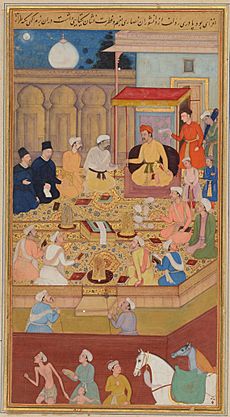
Akbar, the Mughal emperor, had a broad view of Indian and Islamic traditions. He created Din-i-Ilahi (Faith of God), a mix of Islam, Zoroastrianism, Hinduism, Jainism, and Christianity. This was the state religion until he died. These actions were opposed by Muslim religious leaders. Akbar removed the tax on non-Muslims, accepted ideas from other religions, and allowed public worship. His interest in other faiths showed great religious tolerance. Akbar's empire included many Hindu states, especially Rajputs, who kept some control over their religious matters. Many Hindu Rajput vassals built large Hindu temples then.
Akbar's son, Jahangir, was also religiously moderate. His son, Emperor Shah Jahan, continued this policy.
Strict religious rules became important during the rule of Aurangzeb, Shah Jahan's son. Aurangzeb was less tolerant of other faiths. He brought back the jizya tax, doubled customs duties on Hindus, and destroyed Hindu temples. He also forbade building or repairing some non-Muslim temples. He executed the Maratha ruler Sambhaji and the ninth Sikh guru, Guru Tegh Bahadur. His rule saw more Islamic institutions and scholars. He also fought against non-Muslim powers like the Sikh states and Hindu Rajputs. He stopped foreign Christian missionaries from openly converting people in his empire. Hindus in different regions were helped by Marathas, Sikhs, and Rajputs.
Maratha Empire
The Hindu Marathas fought against the Muslim Mughal rulers. Under their leader Chhatrapati Shivaji Maharaj, the Marathas became free from the sultans of Bijapur. They then started raiding Mughal territory. By Shivaji's death in 1680, the Marathas had spread and conquered much of central India. Later, under their Brahmin prime ministers (Peshwas), the Maratha Empire reached its peak. Pune, the Peshwas' seat, became a center of Hindu learning. At its largest, the empire stretched from Tamil Nadu in the south to Peshawar in the north and Bengal in the east.
-
The last Hindu empire of India, the Maratha Empire, in 1760 CE.
Kingdom of Nepal
King Prithvi Narayan Shah, the last Gorkhali ruler, called the newly unified Kingdom of Nepal Asal Hindustan ("Real Land of Hindus"). This was because North India was ruled by the Islamic Mughal rulers. He wanted to enforce Hindu social rules and make Nepal a safe place for Hindus. He called Northern India Mughlan (Country of Mughals) and said it was filled with Muslim foreigners.
After conquering Kathmandu valley, King Prithvi Narayan Shah expelled Christian missionaries. He saw Nepal as Asal Hindustan ("real land of Hindus"). Hindu groups were given special status in the capital. Since then, making Nepal more Hindu became a key policy. Some scholars think the presence of Muslim and Christian rule in India made Nepal want to be a haven for Hindus.
Early Colonialism
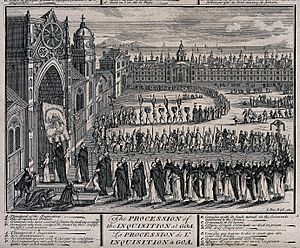
Portuguese missionaries arrived in India in the late 15th century. They met the St Thomas Christians in Kerala and tried to introduce Latin Christian practices. Many new people converted to Christianity during this time.
The Goa Inquisition was a Christian court in the Indian city of Goa. Francis Xavier asked for it to be set up in 1545. It started in 1560 and lasted until 1774. This controversial institution mainly targeted Hindus and new converts who didn't follow Christian rules.
The Battle of Plassey saw the British become a political power. Their rule spread across much of India over the next hundred years. They conquered all Hindu states except the Kingdom of Nepal. The Maratha Empire was the last major Hindu empire until its defeat in the Third Anglo-Maratha War. This left the East India Company in control of most of India. The Sikh Empire in Northwest India was the last area to be conquered by the British. The entire subcontinent came under British rule after the Indian Rebellion of 1857.
Modern Hinduism (After 1850 CE)
With the start of the British Raj (British rule), a Hindu Renaissance began in the 19th century. This greatly changed how Hinduism was understood in India and the West. Indology, the study of Indian culture by Europeans, started in the 19th century. Scholars like Max Müller brought Vedic, Puranic, and Tantric literature to Europe and the United States. Western scholars looked for the "essence" of Indian religions in the Vedas. They created the idea of "Hinduism" as one unified religion and the popular image of 'mystical India'.
This idea of a Vedic essence was adopted by Hindu reform movements like the Brahmo Samaj. These movements were supported by ideas of Universalism (all religions share truth) and Perennialism (all religions have a common mystic core). This "Hindu modernism," with leaders like Vivekananda, became central to how Hinduism was understood.
Hindu Revivalism
In the 19th century, Hinduism saw many new religious movements. These were partly inspired by European ideas like Romanticism and nationalism. According to Paul Hacker, "the ethical values of Neo-Hinduism come from Western philosophy and Christianity, though they use Hindu terms."
These reform movements, called Hindu revivalism, continue today.
- Swaminarayan started the Swaminarayan Sampradaya group around 1800.
- Brahmo Samaj was a social and religious movement founded in Kolkata in 1828 by Raja Ram Mohan Roy. He was influenced by Western thought. The Brahmo religion was founded in 1850 by Debendranath Tagore.
- Ramakrishna and his student Swami Vivekananda led reforms in Hinduism in the late 19th century. Their ideas have inspired many people.
- Arya Samaj ("Society of Nobles") was a Hindu reform movement founded by Swami Dayananda in 1875. He believed in the authority of the Vedas. Dayananda supported karma and reincarnation. He rejected idolatry, animal sacrifices, ancestor worship, pilgrimages, and the caste system, saying they were not in the Vedas. He wanted to make Hinduism a global religion based on the Vedas. The Arya Samaj started the Shuddhi movement to bring back people who had converted to Islam and Christianity.
Contemporary Hinduism
Hinduism is followed by about 1.1 billion people in India. Other large Hindu populations are in Nepal (21.5 million), Bangladesh (13.1 million), and the Indonesian island of Bali (3.9 million). Most of the Vietnamese Cham people also follow Hinduism.
New Hindu Movements in the West
In modern times, Smarta ideas have greatly influenced how Hinduism is understood in India and the West. Vivekananda and Radhakrishnan were important supporters of Smarta views.
Many people helped spread Hinduism to Western audiences. These include Swami Vivekananda, Paramahansa Yogananda, A. C. Bhaktivedanta Swami Prabhupada (Hare Krishna movement), Sri Aurobindo, Meher Baba, Maharishi Mahesh Yogi (Transcendental Meditation), and Sathya Sai Baba.
Hindutva
In the 20th century, Hinduism also became a political force and a source of national identity in India. This movement grew with the idea of Hindutva. It led to the creation of groups like the Rashtriya Swayamsevak Sangh (RSS) in 1925. Later, RSS-linked political parties like the Bharatiya Janata Party (BJP) became successful in India. Hindu religion plays an important role in this nationalist movement.
Besides India, the idea of Hindu nationalism and Hindutva is also seen in other areas with many Hindus. These include Nepal, Bangladesh, Sri Lanka, and Malaysia. Many organizations encourage Hindu identity and nationalism today. In India, Sangh Parivar is a large group for most Hindu nationalist organizations.
-
Rashtriya Swayamsevak Sangh in India.
Images for kids
-
The Yamnaya culture, 3500-2000 BC
-
Scheme of Indo-European migrations from ca. 4000 to 1000 BCE according to the Kurgan hypothesis.
See also
 In Spanish: Historia del hinduismo para niños
In Spanish: Historia del hinduismo para niños


